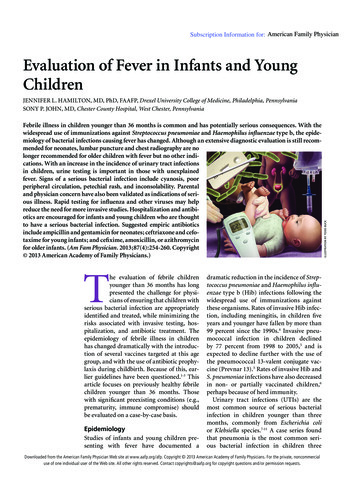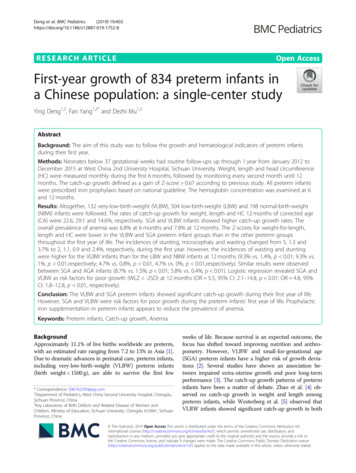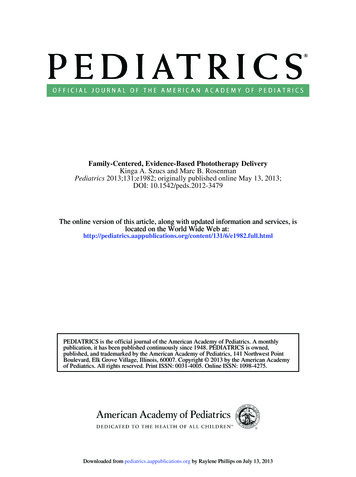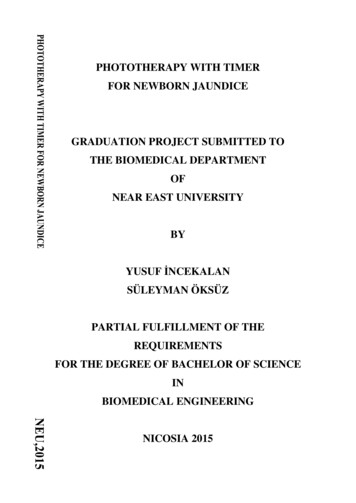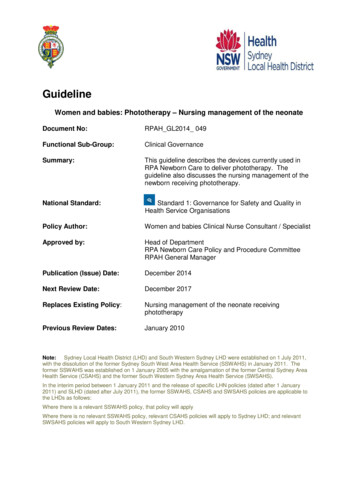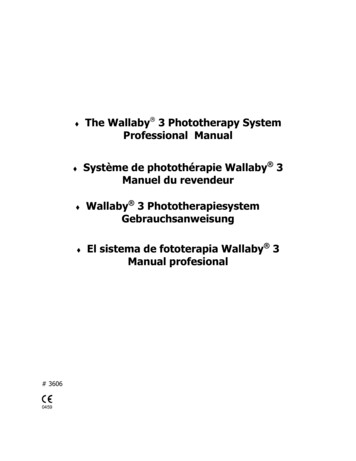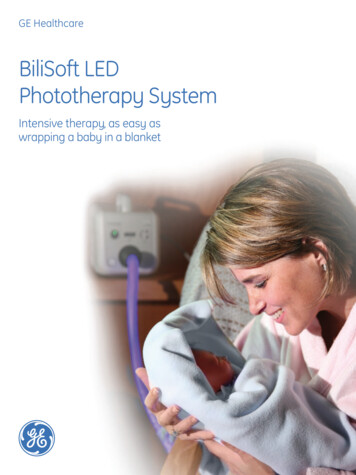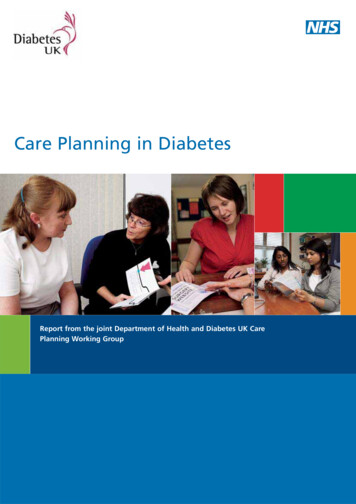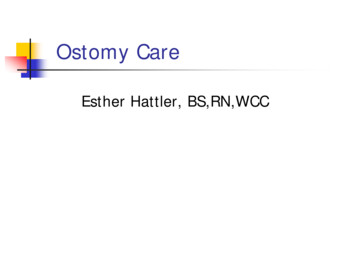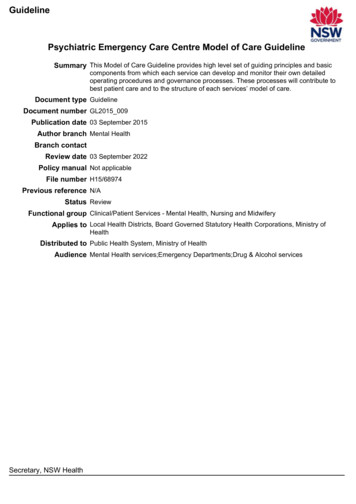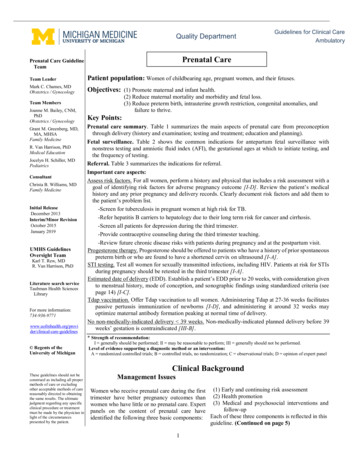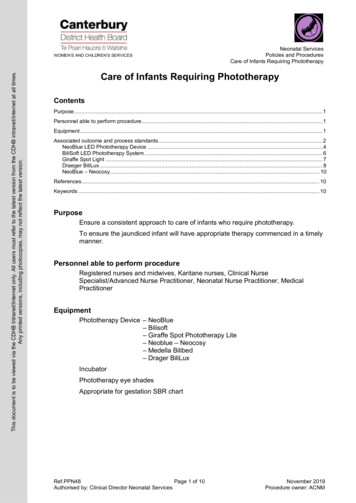
Transcription
This document is to be viewed via the CDHB Intranet/Internet only. All users must refer to the latest version from the CDHB intranet/internet at all times.Any printed versions, including photocopies, may not reflect the latest version.WOMEN’S AND CHILDREN’S SERVICESNeonatal ServicesPolicies and ProceduresCare of Infants Requiring PhototherapyCare of Infants Requiring PhototherapyContentsPurpose. 1Personnel able to perform procedure . 1Equipment . 1Associated outcome and process standards. 2NeoBlue LED Phototherapy Device . 4BiliSoft LED Phototherapy System . 6Giraffe Spot Light . 7Draeger BiliLux . 8NeoBlue – Neocosy . 10References. 10Keywords . 10PurposeEnsure a consistent approach to care of infants who require phototherapy.To ensure the jaundiced infant will have appropriate therapy commenced in a timelymanner.Personnel able to perform procedureRegistered nurses and midwives, Karitane nurses, Clinical NurseSpecialist/Advanced Nurse Practitioner, Neonatal Nurse Practitioner, MedicalPractitionerEquipmentPhototherapy Device – NeoBlue– Bilisoft– Giraffe Spot Phototherapy Lite– Neoblue – Neocosy– Medella Bilibed– Drager BiliLuxIncubatorPhototherapy eye shadesAppropriate for gestation SBR chartRef.PPN48Page 1 of 10Authorised by: Clinical Director Neonatal ServicesNovember 2019Procedure owner: ACNM
Neonatal ServicesPolicies and ProceduresCare of Infants Requiring PhototherapyThis document is to be viewed via the CDHB Intranet/Internet only. All users must refer to the latest version from the CDHB intranet/internet at all times.Any printed versions, including photocopies, may not reflect the latest version.WOMEN’S AND CHILDREN’S SERVICESAssociated outcome and process standardsProcess StepsRationale Explain need for phototherapy andprocedure to parents. Include discussionsregarding minimal handling duringtreatment.Parents fully informed regarding conditionand treatment. Medical staff aware infant is commencingtreatment.To ensure all investigations for risingbilirubins have been completed. Infants withblood group incompatibility, sepsis,polycythaemia, acidosis and prematurity mayrequire further bloods and investigations. Expose as much of the infants bodysurface as is possible to maximisephototherapy treatment. This may includeremoving infant’s nappy, reducing the sizeof the eye protection to expose more ofthe infants head, not covering bilisoft orbilibed with muslin cloths. Ensure skin isclean, dry and oil free.Phototherapy only works on exposed skinsurface. Fasten baby shades, allowing nostrils toremain clear.Shades protect infant’s eyes from the intenselights.Prevents respiratory obstruction. Check infant’s temperature within 30 minsof placing infant under phototherapy.Incubator temperature may need to bereduced, therefore reducing the possibility ofoverheating. Observe for signs of dehydration. Mayneed to increase feed volumes orcommence intravenous fluids. Full explanation to parents of why it isimportant to minimise the time the infant isout from under phototherapy. Consider abilisoft if infant out for breastfeeding andbilirubin levels are not responding totreatment.The more time exposed to lights maximisesthe impact of the treatment. Turn off phototherapy and removephototherapy eye shades with cares– at least 6 hourly.Permits observation of eyes and allowsparents to have interaction with their infants. Regularly check and chart bilirubin levelson appropriate gestational agephototherapy chart. Completely fill the topbox on the phototherapy chart, date andtime of birth, maternal blood group, etc.Discontinue phototherapy treatment whileAllows for trend to be established andidentifies when treatment can bediscontinued.Continuation of phototherapy treatment maylower the blood result minimally.Ref.PPN48Page 2 of 10Authorised by: Clinical Director Neonatal ServicesNovember 2019Procedure owner: ACNM
Neonatal ServicesPolicies and ProceduresCare of Infants Requiring PhototherapyThis document is to be viewed via the CDHB Intranet/Internet only. All users must refer to the latest version from the CDHB intranet/internet at all times.Any printed versions, including photocopies, may not reflect the latest version.WOMEN’S AND CHILDREN’S SERVICESProcess Stepstaking blood samples and recommenceonce sample has been taken.Regularity of bilirubin levels is a medicaldecision and is determined on previouslevels, gestation and condition of theinfant. Record frequency of blood tests onMultidisciplinary Care Pathway.Rationale If you do not get a reading on the bloodgas analyser consider sending sample tothe laboratory. This can occur if a sampleis haemolysed or the infant ispolycythaemic. Samples sent to theCDHB laboratory for processing do notneed to be protected from light.If you are concerned enough to take asample you need to persevere to get a result. When to discontinue phototherapy is anindividual decision based on the clinicalscenario, trend of bilirubin levels andamount of phototherapy required. As ageneral rule wean the amount ofphototherapy gradually and discontinuephototherapy from one light when thebilirubin is well below the treatmentthreshold. Discuss on ward round or withmedical staff.To prevent infants going on and offtreatment. Infants requiring phototherapy in anincubator require cardio respiratorymonitoring if in the neonatal unit or closeobservation if in postnatal. If in a bilibedno monitoring is required.Closer monitoring of infants condition whileunder lights. Phototherapy devices are checkedregularly to ensure irradiance levels areaccurate. If concerns that units are notfunctioning there is a light metre availablein the clinical technicians office. In NICUcheck with ACNM.To ensure devices are functioning correctly.Ref.PPN48Page 3 of 10Authorised by: Clinical Director Neonatal ServicesNovember 2019Procedure owner: ACNM
Neonatal ServicesPolicies and ProceduresCare of Infants Requiring PhototherapyThis document is to be viewed via the CDHB Intranet/Internet only. All users must refer to the latest version from the CDHB intranet/internet at all times.Any printed versions, including photocopies, may not reflect the latest version.WOMEN’S AND CHILDREN’S SERVICESNeoBlue LED Phototherapy DeviceProcess StepsRationale Level of irradiance (µW/cm /nm)2Distance15.2 cm (6”)High**71.930.5 cm (12”)54.240.6 cm (16”)43.345.7 cm (18”)37.861.1 cm (24”)27.0For every 30 cm you move the devicefrom the infant you halve the intensity. The neoblue light can be placed on top ofthe incubator. The closer it is to the infantthe more intense the effect of the light.The light can be positioned horizontallyand vertically.See image regarding how to tilt the light.The rubber feet on the bottom of the lightallows for air flow between the light and thetop of the incubator.The light does not emit ultraviolet or infraredradiation so can be placed close to baby. Ensure the level control button with2 lamps is switched to High.This equates to ‘1 light’ treatment.This ensures the correct radiance of light isachieved.LEVEL CONTROL SWITCHON/OFF SWITCHRED LIGHT TARGET SWITCH Use red light to give central positioning ofthe infant under the lights.This will maximise skin coverage. Place a drape/curtain around the light todecrease the amount of glare from lights.For parent and staff comfort.Ref.PPN48Page 4 of 10Authorised by: Clinical Director Neonatal ServicesNovember 2019Procedure owner: ACNM
Neonatal ServicesPolicies and ProceduresCare of Infants Requiring PhototherapyThis document is to be viewed via the CDHB Intranet/Internet only. All users must refer to the latest version from the CDHB intranet/internet at all times.Any printed versions, including photocopies, may not reflect the latest version.WOMEN’S AND CHILDREN’S SERVICESProcess Steps Neoblue lights do not radiate significantamounts of heat but can affecttemperature within a closed environment.Check the infant’s temperature regularlyuntil stabilised or consider servo controluntil infants temperature has stabilised.RationalePrevents over heating infants. When using Neoblue device with a radiantwarmer care must be taken to angle thelight and position to the side of the heatsource. The source should not be furtherthan 30 cms from the infant.Prevents alteration to temperature control. Neoblue lights can be used in conjunctionwith an infant in an open cot. The lightshould be as close to the baby aspossible. Consideration of infant’stemperature control is required.Maintain thermal regulation. All general process steps apply as above.Ref.PPN48Page 5 of 10Authorised by: Clinical Director Neonatal ServicesNovember 2019Procedure owner: ACNM
Neonatal ServicesPolicies and ProceduresCare of Infants Requiring PhototherapyThis document is to be viewed via the CDHB Intranet/Internet only. All users must refer to the latest version from the CDHB intranet/internet at all times.Any printed versions, including photocopies, may not reflect the latest version.WOMEN’S AND CHILDREN’S SERVICESBiliSoft LED Phototherapy SystemProcess StepsRationale Level of irradiance (µW/cm /nm)49 µW·cm-2·nm2 Ensure the system (grey box) is on flatsurface near the infant, preferably on atrolley not inside the incubator/cot. Plugthe fibre optic cable into the Bilisoft box.Ensure patient safety and protection ofsystem. Insert bilisoft fiberoptic pad into bilisoftcover. The illuminated side labelled ‘thisside facing patient’ should be againstpadded side of cover.Place the infant on the padded side ofcover ensuring maximum area ofillumination is in contact with infant’s skin.Infants can be swaddled or positioningaids utilised to enhance skin exposure tolight. Bilisoft can be used while infant isbreastfeeding.If the infant is wrapped with swaddlingblankets in a cot there is no need to applyeye shades.Ensure maximum irradiance to lower serumbilirubin. All general process steps apply as above.Ref.PPN48Page 6 of 10Authorised by: Clinical Director Neonatal ServicesNovember 2019Procedure owner: ACNM
Neonatal ServicesPolicies and ProceduresCare of Infants Requiring PhototherapyThis document is to be viewed via the CDHB Intranet/Internet only. All users must refer to the latest version from the CDHB intranet/internet at all times.Any printed versions, including photocopies, may not reflect the latest version.WOMEN’S AND CHILDREN’S SERVICESGiraffe Spot LightProcess StepsRationale Level of irradiance (µW/cm /nm)45 μW/cm2/nm – when 38 cm from infant2 Position the Blue Spot Phototherapy lightas close to the infant as possible – can beas close as 38 cms. This provides thehighest level of irradiance. When moving the lamp close to the infant, remember that the whole shaft of the lampis not movable – only the grey areas arebendable.The closer the head of the lamp is to theinfant the higher the irradiance level. All general process steps apply.Ref.PPN48Page 7 of 10Authorised by: Clinical Director Neonatal ServicesNovember 2019Procedure owner: ACNM
Neonatal ServicesPolicies and ProceduresCare of Infants Requiring PhototherapyThis document is to be viewed via the CDHB Intranet/Internet only. All users must refer to the latest version from the CDHB intranet/internet at all times.Any printed versions, including photocopies, may not reflect the latest version.WOMEN’S AND CHILDREN’S SERVICESDraeger BiliLuxProcess Steps INCUBATOR TEMPERATURE MUST BEIMMEDIATELY TURNED DOWN, ORTURNED OFF WHEN USING BiliLuxRationaleThe Draeger Bililux can increase the infant’sbody temperature by more than .5 degrees. Check infant’s temperature within 30minutes of placing infant underphototherapy and then monitor regularlyuntil stable. Consider placing servo controltemperature probe on the infant.The incubator temperature will decrease asinfant’s temperature increases. Minimum of 30 cm distance between theBiliLux and the infant.With 100% irradiance, ie. 5 lampsilluminated, the level of irradiance is:at 30 cm from the infant 85.5 (µW/cm2/nm)40 cm from the infant 50.1 (µW/cm2/nm)50 cm from the infant 33.4 (µW/cm2/nm)There are 5 increments of intensity or5 lamps.Each reduction is equivalent to 20% oftotal irradiation, ie. at 30 cm:5 lamps highlighted 85.5 (µW/cm2/nm)full irradiation4 lamps – 20% 68.4 (µW/cm2/nm)3 lamps – 20% 51.3 (µW/cm2/nm)2 lamps – 20% 34.2 (µW/cm2/nm)1 lamp – 20% 17.1 (µW/cm2/nm)IRRADIANCE DOSE: STARTING PHOTOTHERAPY 5 lamps illuminated (full irradiance) infants close to exchange level orjaundice before 24 hours or haemolyticjaundice. 3 lamps of irradiance for all other infants commencing PT Chart this on the phototherapy chart alongwith any reductions as directed by medicalstaff.NOTE: 5 lamps (equivalent DoublePhototherapy), 3 lamps Standard or SinglePTRef.PPN48Page 8 of 10Authorised by: Clinical Director Neonatal ServicesNovember 2019Procedure owner: ACNM
Neonatal ServicesPolicies and ProceduresCare of Infants Requiring PhototherapyThis document is to be viewed via the CDHB Intranet/Internet only. All users must refer to the latest version from the CDHB intranet/internet at all times.Any printed versions, including photocopies, may not reflect the latest version.WOMEN’S AND CHILDREN’S SERVICESProcess Steps Expose as much of the infants bodysurface as is possible to maximisephototherapy treatment. This may includeremoving infant’s nappy, reducing the sizeof the eye protection to expose more ofthe infant’s head. Ensure skin is clean, dryand oil free. Place the BiliLux onto incubator over theinfant with a minimum distance of 30 cmbetween the light and the infant.RationalePhototherapy onlyworks on exposedskin surface.If less than 30 cm distance between BiliLuxand infant then harm may be caused to theinfant.1. Ensure infants eyes are protected by eyeshields.2. Press the start key on the control panel toturn on phototherapy light.3. Adjust the irradiance to the desired levelusing the intensity keys on the controlpanel. Left hand button to decrease andright hand button to increase intensity.The button with the head and light is theobservation light, the effect of thephototherapy is not affected whenobservation light is on. CONSIDERATIONS FOR SAFE USE The Bililux unit should always be leftuncovered. Shade curtain can be used (as long asunit not covered). Bililux may be placed directly on top ofincubator: Caution as may fall off if incubatormoved or if on incubator hood withupward travel (eg. Leo/giraffe). Unplug and remove before movingincubator or moving hood up. The observation light can be turned on atthe same time the phototherapy light isoperating to soften the intensity of the bluelight without altering effectiveness ofphototherapy unit. Useful whenphototherapy light on if finding intensity oflight disturbing to eyes of staff or parents.Ref.PPN48Page 9 of 10Authorised by: Clinical Director Neonatal ServicesNovember 2019Procedure owner: ACNM
Neonatal ServicesPolicies and ProceduresCare of Infants Requiring PhototherapyThis document is to be viewed via the CDHB Intranet/Internet only. All users must refer to the latest version from the CDHB intranet/internet at all times.Any printed versions, including photocopies, may not reflect the latest version.WOMEN’S AND CHILDREN’S SERVICESNeoBlue – NeocosyProcess StepsRationale Level of irradiance (µW/cm /nm) 30 μW/cm2/nm2 Position the neoBLUE cozy device so thatthe air vents are not covered by blanketsor clothing or positioned againstobstructing surfaces.Place the covered neoBLUE cozymattress into the neoBLUE cozy systemso that it lies flat.Ensures unit does not overheat. The infants head should be positioned atthe curved end of the device. The infantshould be placed with his/her back againstthe mattress. A blanket may be placedover the infant for added warmth.Maintain infants temperature. The operating temperature for theneoBLUE cozy device is 20-30oC.Though the device will initially operate inwarmer conditions when new, use in warmerenvironments will shorten the life of the LEDpanel. All general process steps apply.ReferencesInservice Guide, NeoBlue LED phototherapy, Natus Medical Inco, 5900 First Avenue South,Seattle WA 98108 USA.Bilisoft LED Phototherapy System - Education - GE Healthcare (2016) ManufacturersGuidelines, GE Healthcare 8880 Gorman Road Laurel, MD 20723 U.S.A.Giraffe Blue Spot PT Lite Phototherapy System. Manufacturers Guide. GE cooperate June2014 Product safety InformationNeoBlue cozy LED phototherapy, Manufacturers guidelines, Natus Medical Incorporated,2012Manufacturers guidelines. Medela Bilibed Phototherapy,Medella Inc, 2016KeywordsPhototherapy, Bilibed, Bilisoft, Neoblue, NeoCosy, Giraffe Spot, Draeger BiliLuxRef.PPN48Page 10 of 10Authorised by: Clinical Director Neonatal ServicesNovember 2019Procedure owner: ACNM
The more time exposed to lights maximises the impact of the treatment. Turn off phototherapy and remove phototherapy eye shades with cares – at least 6 hourly. Permits observation of eyes and allows parents to have interaction with their infants. Regularly check and chart bilirubin
